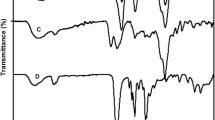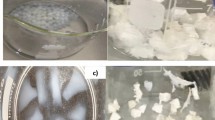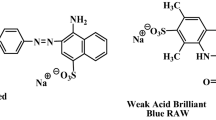Abstract
Calcium alginate hydrogel was grafted with poly (styrene-co-maleic anhydride) synthetic polymer (PSMA) and used as an adsorbent for the effective removal of methyl violet 6B cationic dye from aqueous solutions. The characteristics of native and grafted alginate hydrogels were investigated using FTIR, Zetasizer and TGA/DSC. The carboxyl groups’ content and the swelling properties were determined as well. Batch adsorption experiments were conducted as a function of initial dye concentration, adsorbent dosage, solution ionic strength, solution pH, time of contact and temperature. Results revealed that grafting of PSMA onto alginate improved the removal percentage of the dye up to 30%. The highest adsorption capacity of the dye was obtained at a temperature of 40 °C, a pH range of 5–11 and at lower solution ionic strengths. The kinetics of adsorption followed the pseudo-second-order model and the equilibrium data could be better described by the Langmuir isotherm. The maximum adsorption capacity was found to be 109.9 mg/g suggesting the promising potential of our low-cost adsorbent for the removal of cationic dyes from aqueous solutions. A desorption study was carried out where the adsorbent showed high desorption characteristics and it could be reused at least for five consecutive cycles.













Similar content being viewed by others
Abbreviations
- S %:
-
The swelling percentage
- W s :
-
The weight of the swollen dried beads
- W o :
-
The weight of the dried beads
- C NaOH :
-
The concentration of the NaOH solution (mol/L)
- V NaOH :
-
The volume of the NaOH solution (L)
- C HCl :
-
The concentration of the HCl solution (mol/L)
- V HCl :
-
The volume of HCl spent in the titration of the excessive non-reacted base (L)
- m :
-
The dry mass of the beads (g)
- C o :
-
The initial methyl violet concentration (mg/L)
- C t :
-
The methyl violet concentration at time t (mg/L)
- m :
-
The mass of adsorbent (g)
- V :
-
The volume of solution (L)
- C e :
-
The methyl violet concentration at equilibrium (mg/L)
- q t :
-
The adsorption capacities of methyl violet at time (mg/g)
- q e :
-
The adsorption capacities of methyl violet at equilibrium (mg/g)
- k 1 :
-
The pseudo-first-order rate constant of adsorption (min−1)
- k 2 :
-
The pseudo-second-order rate constant of adsorption (g mg−1 min−1)
- R 2 :
-
The linear regression correlation coefficient
- k d :
-
The intraparticle diffusion rate constant (mg g−1 min−1/2)
- C :
-
A constant related to the thickness of the boundary layer (mg/L)
- q max :
-
A constant stands for the maximum adsorption capacity (mg/g)
- k L :
-
Langmuir isotherm constant related to the affinity of the adsorbate with the adsorbent (L/mg)
- R L :
-
A dimensionless separation factor that indicates the type of Langmuir isotherm whether it is favorable, unfavorable or linear
- k F :
-
The Freundlich isotherm constant (mg(1−1/n) L(1/n) g−1)
- n :
-
A constant related to the adsorption intensity and the degree of heterogeneity of the adsorbent surface
- K c :
-
The dimensionless equilibrium constant
- ΔS°:
-
The standard entropy change during the adsorption process (J mol−1 K−1)
- ΔH°:
-
The standard enthalpy change during the adsorption process (J/mol)
- ΔG°:
-
The standard Gibbs free energy change during the adsorption process (J/mol)
- R :
-
The universal gas constant (8.314 J mol−1 K−1)
- T :
-
The temperature (K)
- E a :
-
The activation energy of an adsorption process (J/mol)
- A :
-
A temperature-independent constant called frequency factor (g/mg min)
References
Alqaragully MB (2014) Removal of textile dyes (maxilon blue, and methyl orange) by date stones activated carbon. Int J Adv Res Chem Sci 1(1):8–59
Dawood SaS T (2014) Review on dye removal from its aqueous solution into alternative cost effective and non-conventional adsorbents. J Chem Process Eng 1(104):1–11
Mani S, Bharagava RN (2016) Exposure to crystal violet, its toxic, genotoxic and carcinogenic effects on environment and its degradation and detoxification for environmental safety, vol 237. In: Reviews of environmental contamination and toxicology. Springer International Publishing, Cham. https://doi.org/10.1007/978-3-319-23573-8_4
Pereira L, Alves M (2012) Dyes-Environmental impact and remediation. Environmental protection strategies for sustainable development. Springer Netherlands, Dordrecht. https://doi.org/10.1007/978-94-007-1591-2_4
Li Y, Nie W, Chen P, Zhou Y (2016) Preparation and characterization of sulfonated poly(styrene-alt-maleic anhydride) and its selective removal of cationic dyes. Colloids Surf Physicochem Eng Asp 499:46–53. https://doi.org/10.1016/j.colsurfa.2016.04.009
Crini G (2005) Recent developments in polysaccharide-based materials used as adsorbents in wastewater treatment. Prog Polym Sci 30(1):38–70. https://doi.org/10.1016/j.progpolymsci.2004.11.002
Crini G (2006) Non-conventional low-cost adsorbents for dye removal: a review. Bioresour Technol 97(9):1061–1085. https://doi.org/10.1016/j.biortech.2005.05.001
Sudha PN, Gomathi T, Vinodhini PA, Nasreen K (2014) Chapter Seven: Marine carbohydrates of wastewater treatment, vol 73. In Advances in food and nutrition research. Academic. doi:http://dx.doi.org/10.1016/B978-0-12-800268-1.00007-X
Kyzas GZ, Bikiaris DN, Mitropoulos AC (2017) Chitosan adsorbents for dye removal: a review. Polym Int 66(12):1800–1811. https://doi.org/10.1002/pi.5467
Oladoja NA, Unuabonah EI, Amuda OS, Kolawole OM (2017) Polysaccharides as a green and sustainable resources for water and wastewater treatment. Springer, New York
Ahmed EM (2015) Hydrogel: preparation, characterization, and applications: A review. J Adv Res 6(2):105–121. https://doi.org/10.1016/j.jare.2013.07.006
Zhang X, Li H, Cao M, Shi L, Chen C (2015) Adsorption of basic dyes on β-cyclodextrin functionalized poly (styrene-alt-maleic anhydride). Sep Sci Technol 50(7):947–957. https://doi.org/10.1080/01496395.2014.978461
Zhou Y, Zhang M, Hu X, Wang X, Niu J, Ma T (2013) Adsorption of cationic dyes on a cellulose-based multicarboxyl adsorbent. J Chem Eng Data 58(2):413–421. https://doi.org/10.1021/je301140c
Vakili M, Rafatullah M, Salamatinia B, Abdullah AZ, Ibrahim MH, Tan KB, Gholami Z, Amouzgar P (2014) Application of chitosan and its derivatives as adsorbents for dye removal from water and wastewater: a review. Carbohydr Polym 113:115–130. https://doi.org/10.1016/j.carbpol.2014.07.007
Ghorai S, Sarkar A, Raoufi M, Panda AB, Schönherr H, Pal S (2014) Enhanced removal of methylene blue and methyl violet dyes from aqueous solution using a nanocomposite of hydrolyzed polyacrylamide grafted xanthan gum and incorporated nanosilica. ACS Appl Mater Int 6(7):4766–4777. https://doi.org/10.1021/am4055657
Güçlü G, Keleş S (2007) Removal of basic dyes from aqueous solutions using starch-graft-acrylic acid copolymers. J Appl Polym Sci 106(4):2422–2426. https://doi.org/10.1002/app.26778
J-s Yang, S-y Han, Yang L, H-c Zheng (2016) Synthesis of beta-cyclodextrin-grafted-alginate and its application for removing methylene blue from water solution. J Chem Technol Biotechnol 91(3):618–623. https://doi.org/10.1002/jctb.4612
Tsai B, Garcia-Valdez O, Champagne P, Cunningham M (2017) Poly(poly(ethylene glycol) methyl ether methacrylate) grafted chitosan for dye removal from water. Processes 5(1):12
Xu B, Zheng H, Zhou H, Wang Y, Luo K, Zhao C, Peng Y, Zheng X (2018) Adsorptive removal of anionic dyes by chitosan-based magnetic microspheres with pH-responsive properties. J Mol Liq. https://doi.org/10.1016/j.molliq.2018.02.061
Chen X, Liu L, Luo Z, Shen J, Ni Q, Yao J (2018) Facile preparation of a cellulose-based bioadsorbent modified by hPEI in heterogeneous system for high-efficiency removal of multiple types of dyes. React Funct Polym. https://doi.org/10.1016/j.reactfunctpolym.2018.02.009
Sharma J, Sukriti Anand P, Pruthi V, Chaddha AS, Bhatia J, Kaith BS (2017) RSM-CCD optimized adsorbent for the sequestration of carcinogenic rhodamine-B: kinetics and equilibrium studies. Mater Chem Phys 196:270–283. https://doi.org/10.1016/j.matchemphys.2017.04.042
Draget KI, Smidsrød O, Skjåk-Bræk G (2005) Alginates from algae. Biopolymers online. Wiley, New York. https://doi.org/10.1002/3527600035.bpol6008
Mahmoodi NM (2011) Equilibrium, kinetics, and thermodynamics of dye removal using alginate in binary systems. J Chem Eng Data 56(6):2802–2811. https://doi.org/10.1021/je101276x
Aravindhan R, Fathima NN, Rao JR, Nair BU (2007) Equilibrium and thermodynamic studies on the removal of basic black dye using calcium alginate beads. Colloids Surf Physicochem Eng Asp 299(1–3):232–238. https://doi.org/10.1016/j.colsurfa.2006.11.045
Mahmoodi NM, Hayati B, Arami M (2012) Kinetic, equilibrium and thermodynamic studies of ternary system dye removal using a biopolymer. Ind Crops Prod 35(1):295–301. https://doi.org/10.1016/j.indcrop.2011.07.015
van Wijk J, van Deventer N, Harmzen E, Meuldijk J, Klumperman B (2014) Formation of hybrid poly (styrene-co-maleic anhydride)-silica microcapsules. J Mater Chem B 2(30):4826–4835. https://doi.org/10.1039/C4TB00473F
Abo-Baker E, Elkholy SS, Elsabee MZ (2015) Modified poly (styrene maleic anhydride) copolymer for the removal of toxic metal cations from aqueous solutions. Am J Polym Sci 5(3):55–64
Chen S, Zhang J, Zhang C, Yue Q, Li Y, Li C (2010) Equilibrium and kinetic studies of methyl orange and methyl violet adsorption on activated carbon derived from Phragmites australis. Desalination 252(1–3):149–156. https://doi.org/10.1016/j.desal.2009.10.010
Bouasla C, Samar ME-H, Ismail F (2010) Degradation of methyl violet 6B dye by the Fenton process. Desalination 254(1–3):35–41. https://doi.org/10.1016/j.desal.2009.12.017
Karnitz O Jr, Gurgel LVA, de Melo JCP, Botaro VR, Melo TMS, de Freitas Gil RP, Gil LF (2007) Adsorption of heavy metal ion from aqueous single metal solution by chemically modified sugarcane bagasse. Bioresour Technol 98(6):1291–1297. https://doi.org/10.1016/j.biortech.2006.05.013
Ho YS, McKay G (1999) Pseudo-second order model for sorption processes. Process Biochem 34(5):451–465. https://doi.org/10.1016/S0032-9592(98)00112-5
Ho YS, McKay G (2000) The kinetics of sorption of divalent metal ions onto sphagnum moss peat. Water Res 34(3):735–742. https://doi.org/10.1016/S0043-1354(99)00232-8
Weber WJ, Morris JC (1963) Kinetics of adsorption on carbon from solution. J Sanit Eng Div Am Soc Civ Eng 89(2):31–60
Iqbal MZ, Abdala AA (2013) Thermally reduced graphene: synthesis, characterization and dye removal applications. RSC Adv 3(46):24455–24464. https://doi.org/10.1039/C3RA43914C
Foo K, Hameed B (2010) Insights into the modeling of adsorption isotherm systems. Chem Eng J 156(1):2–10
Langmuir I (1916) The constitution and fundamental properties of solids and liquids. J Am Chem Soc 38(11):2221–2295. https://doi.org/10.1021/ja02268a002
Hameed BH (2008) Equilibrium and kinetic studies of methyl violet sorption by agricultural waste. J Hazard Mater 154(1–3):204–212. https://doi.org/10.1016/j.jhazmat.2007.10.010
Freundlich HMF (1906) Uber die adsorption in losungen. Z Phys Chem 57(A):385
Hasley GD (1952) The role of surface heterogeneity. Adv Catal 4:259–269
Xu J, Wang L, Zhu Y (2012) Decontamination of bisphenol A from aqueous solution by graphene adsorption. Langmuir 28(22):8418–8425. https://doi.org/10.1021/la301476p
Zhou X, Zhou X (2014) The unit problem in the thermodynamic calculation of adsorption using the Langmuir equation. Chem Eng Commun 201(11):1459–1467. https://doi.org/10.1080/00986445.2013.818541
Saha P, Chowdhury S (2011) Insight into adsorption thermodynamics. INTECH Open Access Publisher, London
Li Y, Liu F, Xia B, Du Q, Zhang P, Wang D, Wang Z, Xia Y (2010) Removal of copper from aqueous solution by carbon nanotube/calcium alginate composites. J Hazard Mater 177(1–3):876–880. https://doi.org/10.1016/j.jhazmat.2009.12.114
Li P, Dai Y-N, Zhang J-P, Wang A-Q, Wei Q (2008) Chitosan-alginate nanoparticles as a novel drug delivery system for nifedipine. Int J Biomed Sci 4(3):221–228
Sartori C, Finch DS, Ralph B, Gilding K (1997) Determination of the cation content of alginate thin films by FTi.r. spectroscopy. Polymer 38(1):43–51. https://doi.org/10.1016/S0032-3861(96)00458-2
Barra GMO, Crespo JS, Bertolino JR, Soldi V, Pires ATN (1999) Maleic anhydride grafting on epdm: qualitative and quantitative determination. J Braz Chem Soc 10:31–34
Ferreira PJ, Gamelas JA, Moutinho IM, Ferreira AG, Gómez N, Molleda C, Figueiredo MM (2009) Application of FT-IR-ATR spectroscopy to evaluate the penetration of surface sizing agents into the paper structure. Ind Eng Chem Res 48(8):3867–3872. https://doi.org/10.1021/ie801765c
Teacă C-A, Bodîrlău R, Spiridon I (2014) Maleic anhydride treatment of softwood-effect on wood structure and properties. Cellul Chem Technol 48(9–10):863–868
Işıklan N, Kurşun F, İnal M (2010) Graft copolymerization of itaconic acid onto sodium alginate using benzoyl peroxide. Carbohydr Polym 79(3):665–672. https://doi.org/10.1016/j.carbpol.2009.09.021
Teixeira VF, Pereira NR, Waldman WR, Avila AL, Perez VH, Rodriguez RJ (2014) Ion exchange kinetics of magnetic alginate ferrogel beads produced by external gelation. Carbohydr Polym 111:198–205. https://doi.org/10.1016/j.carbpol.2014.04.009
Zhang J, Ji Q, Shen X, Xia Y, Tan L, Kong Q (2011) Pyrolysis products and thermal degradation mechanism of intrinsically flame-retardant calcium alginate fibre. Polym Degrad Stab 96(5):936–942. https://doi.org/10.1016/j.polymdegradstab.2011.01.029
Ahmad R (2009) Studies on adsorption of crystal violet dye from aqueous solution onto coniferous pinus bark powder (CPBP). J Hazard Mater 171(1–3):767–773. https://doi.org/10.1016/j.jhazmat.2009.06.060
Bulut Y, Aydın H (2006) A kinetics and thermodynamics study of methylene blue adsorption on wheat shells. Desalination 194(1–3):259–267. https://doi.org/10.1016/j.desal.2005.10.032
Chakraborty S, Chowdhury S, Das Saha P (2011) Adsorption of crystal violet from aqueous solution onto NaOH-modified rice husk. Carbohydr Polym 86(4):1533–1541. https://doi.org/10.1016/j.carbpol.2011.06.058
Liu R, Zhang B, Mei D, Zhang H, Liu J (2011) Adsorption of methyl violet from aqueous solution by halloysite nanotubes. Desalination 268(1–3):111–116. https://doi.org/10.1016/j.desal.2010.10.006
Sargin İ, Ünlü N (2013) Insights into cationic methyl violet 6B dye–kaolinite interactions: kinetic, equilibrium and thermodynamic studies. Clay Miner 48(1):85–95
Luo W-J, Gao Q, Wu X-L, Zhou C-G (2014) Removal of cationic dye (methylene blue) from aqueous solution by humic acid-modified expanded perlite: experiment and theory. Sep Sci Technol 49(15):2400–2411. https://doi.org/10.1080/01496395.2014.920395
Li Y, Hu M, Du Y, Xiao H, McClements DJ (2011) Control of lipase digestibility of emulsified lipids by encapsulation within calcium alginate beads. Food Hydrocoll 25(1):122–130. https://doi.org/10.1016/j.foodhyd.2010.06.003
Ge F, Ye H, Li M-M, Zhao B-X (2012) Efficient removal of cationic dyes from aqueous solution by polymer-modified magnetic nanoparticles. Chem Eng J 198–199:11–17. https://doi.org/10.1016/j.cej.2012.05.074
Mittal A, Mittal J, Malviya A, Kaur D, Gupta VK (2010) Adsorption of hazardous dye crystal violet from wastewater by waste materials. J Colloid Interface Sci 343(2):463–473. https://doi.org/10.1016/j.jcis.2009.11.060
Rahchamani J, Mousavi HZ, Behzad M (2011) Adsorption of methyl violet from aqueous solution by polyacrylamide as an adsorbent: isotherm and kinetic studies. Desalination 267(2–3):256–260. https://doi.org/10.1016/j.desal.2010.09.036
Doğan M, Özdemir Y, Alkan M (2007) Adsorption kinetics and mechanism of cationic methyl violet and methylene blue dyes onto sepiolite. Dyes Pigm 75(3):701–713. https://doi.org/10.1016/j.dyepig.2006.07.023
Doğan M, Alkan M (2003) Adsorption kinetics of methyl violet onto perlite. Chemosphere 50(4):517–528. https://doi.org/10.1016/S0045-6535(02)00629-X
Ghorai S, Sarkar AK, Panda AB, Pal S (2013) Effective removal of congo red dye from aqueous solution using modified xanthan gum/silica hybrid nanocomposite as adsorbent. Bioresour Technol 144:485–491. https://doi.org/10.1016/j.biortech.2013.06.108
Allen SJ, McKay G, Khader KYH (1989) Intraparticle diffusion of a basic dye during adsorption onto sphagnum peat. Environ Pollut 56(1):39–50. https://doi.org/10.1016/0269-7491(89)90120-6
Elass K, Laachach A, Alaoui A, Azzi M (2011) Removal of methyl violet from aqueous solution using a stevensite-rich clay from Morocco. Appl Clay Sci 54(1):90–96. https://doi.org/10.1016/j.clay.2011.07.019
Saeed A, Sharif M, Iqbal M (2010) Application potential of grapefruit peel as dye sorbent: kinetics, equilibrium and mechanism of crystal violet adsorption. J Hazard Mater 179(1–3):564–572. https://doi.org/10.1016/j.jhazmat.2010.03.041
Dai M (1998) Mechanism of adsorption for dyes on activated carbon. J Colloid Interface Sci 198(1):6–10. https://doi.org/10.1006/jcis.1997.5254
Azizian S, Haerifar M, Bashiri H (2009) Adsorption of methyl violet onto granular activated carbon: equilibrium, kinetics and modeling. Chem Eng J 146(1):36–41. https://doi.org/10.1016/j.cej.2008.05.024
Mall ID, Srivastava VC, Agarwal NK (2006) Removal of orange-G and methyl violet dyes by adsorption onto bagasse fly ash-kinetic study and equilibrium isotherm analyses. Dyes Pigm 69(3):210–223. https://doi.org/10.1016/j.dyepig.2005.03.013
Özdemir Y, Doğan M, Alkan M (2006) Adsorption of cationic dyes from aqueous solutions by sepiolite. Microporous Mesoporous Mater 96(1–3):419–427. https://doi.org/10.1016/j.micromeso.2006.07.026
Annadurai G, Juang RS, Lee DJ (2002) Use of cellulose-based wastes for adsorption of dyes from aqueous solutions. J Hazard Mater 92(3):263–274
Xu S, Wang J, Wu R, Wang J, Li H (2006) Adsorption behaviors of acid and basic dyes on crosslinked amphoteric starch. Chem Eng J 117(2):161–167. https://doi.org/10.1016/j.cej.2005.12.012
Ghasemi M, Mashhadi S, Asif M, Tyagi I, Agarwal S, Gupta VK (2016) Microwave-assisted synthesis of tetraethylenepentamine functionalized activated carbon with high adsorption capacity for malachite green dye. J Mol Liq 213:317–325. https://doi.org/10.1016/j.molliq.2015.09.048
Wang XS, Li ZZ, Tao SR (2009) Removal of chromium (VI) from aqueous solution using walnut hull. J Environ Manage 90(2):721–729. https://doi.org/10.1016/j.jenvman.2008.01.011
Nollet H, Roels M, Lutgen P, Van der Meeren P, Verstraete W (2003) Removal of PCBs from wastewater using fly ash. Chemosphere 53(6):655–665. https://doi.org/10.1016/S0045-6535(03)00517-4
Blackburn RS (2004) Natural polysaccharides and their interactions with dye molecules: applications in effluent treatment. Environ Sci Technol 38(18):4905–4909. https://doi.org/10.1021/es049972n
Parker HL, Hunt AJ, Budarin VL, Shuttleworth PS, Miller KL, Clark JH (2012) The importance of being porous: polysaccharide-derived mesoporous materials for use in dye adsorption. RSC Adv 2(24):8992–8997
Abramian L, El-Rassy H (2009) Adsorption kinetics and thermodynamics of azo-dye orange II onto highly porous titania aerogel. Chem Eng J 150(2–3):403–410. https://doi.org/10.1016/j.cej.2009.01.019
Garde JA, CatalÁ R, Gavara R, Hernandez RJ (2001) Characterizing the migration of antioxidants from polypropylene into fatty food simulants. Food Addit Contam 18(8):750–762. https://doi.org/10.1080/02652030116713
Acknowledgement
This work was supported by The Petroleum Institute Research Center, Abu Dhabi, UAE (Grant Number LTR14013).
Author information
Authors and Affiliations
Corresponding author
Rights and permissions
About this article
Cite this article
Eskhan, A., Banat, F., Selvaraj, M. et al. Enhanced removal of methyl violet 6B cationic dye from aqueous solutions using calcium alginate hydrogel grafted with poly (styrene-co-maleic anhydride). Polym. Bull. 76, 175–203 (2019). https://doi.org/10.1007/s00289-018-2378-y
Received:
Revised:
Accepted:
Published:
Issue Date:
DOI: https://doi.org/10.1007/s00289-018-2378-y




